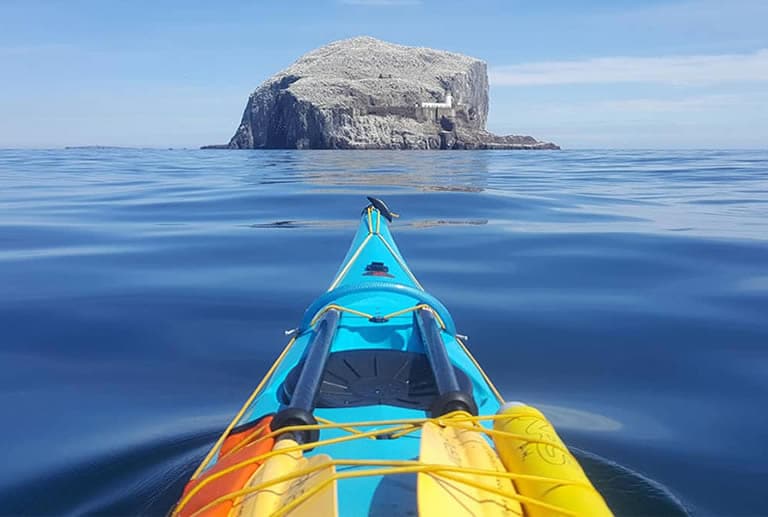If you are drawn to the open, expansive azure shades of calm seas, blue skies, and a level horizon, then ocean kayaking may just be for you. But, of course navigating the sea doesn’t always involve calm waters and easy paddling. This form of kayaking comes with its own set of challenges.
Contents
A Guide To Sea Kayaking For Beginners
Before we begin let’s answer the question, “can you kayak in the ocean”?
The answer is yes. However, you must only go ocean kayaking in a seaworthy kayak.
The best ocean kayaks are not only seaworthy but they are also lightweight and able to carry a fairly large amount of safety gear.
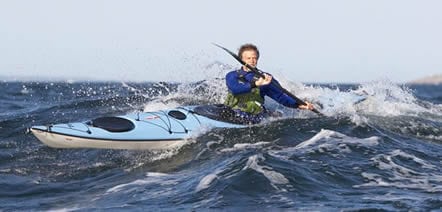
In this guide to ocean kayaking for beginners we will show you how to develop the necessary skills for taking to the ocean, how to get started and how to take it to the next level.
We also point out the dangers involved with ocean kayaking and show you what gear you need to make sure you remain safe.
The Difference Between Ocean Kayaking & Other Forms Of Kayaking
Kayaking in open waters, such as the ocean, requires a different set of skills to recreational kayaking due to currents, waves and the wind.
On calm waters ocean kayaking requires no more skill than kayaking on a river or lake.
However, open waters, especially the ocean, have currents that are constantly moving and jostling your boat.
You therefore need to be paddling almost constantly just to stay on course.
This means you need to have a certain level of fitness and core strength that you would not normally need for other kayaking activities.
Although you can take courses on proper technique for ocean kayaking, if you are able to kayak safely and effectively on calm inland waters then you will be able to quickly develop the skills needed to kayak in open waters.
You just need to be smart about how you develop those skills (we will cover how to do that later).
Ocean kayaking in challenging conditions is only for competent and experienced kayakers who can execute the key maneuvers and techniques needed for safe kayaking in troubled water.
Long distance ocean kayaking is usually the preserve of experienced lone kayakers or groups who have the confidence and skill to cover the distances involved while navigating the challenging waters that often go hand-in-hand with open water boating.
The biggest difference you will notice between ocean kayaking and inland recreational kayaking (apart from the extra physical effort required) will be the stability of the kayak you are using.
Recreational kayaks tend to be flat-bottomed boats with straight sides.
As we pointed out in this article a flat bottom kayak offers exceptional stability on calm water because it basically “sits” on the water.
However, for ocean waves and choppy water you need something that can “roll” better with the moving water.
This is why ocean kayaks are more rounded at the sides than recreational kayaks.
The rounded hull of a ocean kayak makes it feel tippy especially to people who are more use to recreational kayaks.
This tippy feeling, where the boat easily rocks from side-to-side as the paddler moves even slightly, can be problematic for new users.
Be assured though that it doesn’t take very long to adjust to this new style of kayak especially if you have any previous experience in any other type of kayak.
Some kayaking techniques that are often employed while ocean kayaking include:
- Torso rotation. Using the hole upper body in paddling movements, so that your arms don’t do all the work. Separating the functions of the upper and lower body also will enable you to perform the more advanced paddling maneuvers needed for rough conditions.
- Bracing. Bracing is a technique that counteracts a kayak that is rolling and at risk of capsizing. It is a critical skill for remaining stable in a narrow ocean kayak.
- Eskimo roll. Eskimo rolling (or just “rolling“) is a maneuver that rights a capsized kayak using only body movements and the paddle. Rolling clinics are available to assist you in building this skill if you feel that you need help.
Sea kayaking is much more than just ocean kayaking
Before we venture deeper into the topic of ocean kayaking we need to address the obvious question – what is sea kayaking?
We can think of sea kayaking as the activity of paddling, on large open bodies of water such as the ocean or large lakes, in a seaworthy kayak.
Sea kayaking and ocean kayaking are the same thing and refer to kayaking activities that are engaged in on large open bodies of water.
This type of kayaking is also known as touring kayaking and these three terms are often used interchangeably to mean the same thing.
Although the names sea kayaking and ocean kayaking bring to mind boating in the open ocean, this form of kayaking actually refers to paddling in any type of open bodies of water.
These open bodies of water may be the open ocean but can also be coastal bays and even large lakes.
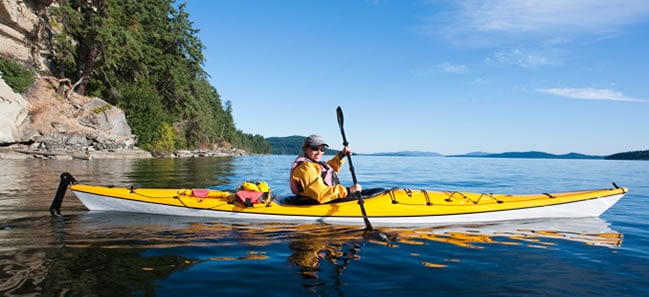
For this reason many enthusiasts think that the terms sea kayaking and ocean kayaking are therefore insufficient for explaining the activity.
Many believe the more accurate term for this type of kayaking is touring kayaking.
However, if truth be told, the term touring kayaking is also insufficient to fully describe this form of kayaking. This term implies embracing explorations of large bodies of water on long journeys such as with boat camping.
Although this form of open water kayaking can involve long journeys and even several days spent paddling at sea it can just as easily involve a 30 minute paddle in the ocean.
So touring kayaking does not totally describe this activity properly either because even though you may be using a touring kayak you may not be doing any touring and may only be paddling for a short period.
So to put it in simple terms, sea kayaking, ocean kayaking and touring kayaking can be a mixture of adventure and endurance or a simple day spent on open waters.
Sea and ocean kayaking can therefore be thought of as any activity performed on any large body of open water, in a seaworthy kayak.
In this article, we will take a look at the basics of undertaking an ocean kayaking expedition.
The risks involved, the equipment you need and some key techniques that will keep you safe on open waters.
Essential ocean kayak safety starts with preparation
There are several things you can do to prepare yourself for ocean kayaking.
These preparations should be adhered to even before you start learning how paddle in open water.
If you are not new to kayaking, and have kayaked in rivers, ponds or creeks, then the following information will likely not be new to you.
If you are an experienced kayaker then you will probably be fully appreciate the importance of the advice given.
Just be aware though that open water kayaking, whether it be in the ocean or just a large open lake, is different from other forms of kayaking and requires different paddling skills.
If you are new, or relatively new, to kayaking then follow the preparation steps very closely.
You need a seaworthy ocean kayak
The first thing you should be sure of before trying open water kayaking involves your kayak.
Are you sure the kayak you intend to use on open waters is seaworthy?
As we covered in this article, not having the right kayak for the job is probably the biggest mistake new kayakers make,. This is true regardless of what type of kayaking activity they are involved in.
However, when it comes to ocean kayaking it is vitally important you have the correct type of kayak!
As you will now appreciate, after reading some of the risks involved with ocean kayaking, it is absolutely essential that you are properly prepared and equipped for your time on the water.
This starts with your choice of vessel.
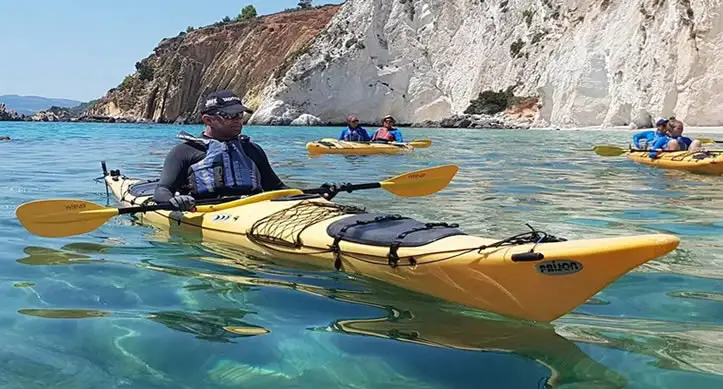
It is of critical importance that you use a seaworthy kayak not just to improve your performance at sea but for key safety reasons.
Sea, or touring kayaks, are specifically designed for seaworthiness and possess a number of key features:
- Shape – Ocean-going kayaks have an elongated design that makes them easy to paddle straight and they cut through the water much better than other types of kayaks.
- Length – Ocean kayaks usually have a length of between 12 and 18 feet and a tandem ocean kayak can go be as much as 26 feet in length.
- Width – Width adds stability to a kayak but this has to be balanced against the kayak’s ability to move quickly through the water. Ocean kayaks tend to limit width to between 21 and 36 inches so the kayak is in that sweet spot between speed and stability.
- Hull Design – Ocean kayaks have a rounded or v-shaped hull for a deeper draft and better secondary stability. They also cut through the water better than other kayak types. Rounded sides impart more rocker and offer better stability in choppy waters.
- High cruising speeds – The design of an ocean kayak facilitates fast movement through the water, from less physical effort, making them ideal for long distance paddling.
- Large capacity – These kayaks are designed to carry the amount of cargo needed for an extended journey. The loading of these kayaks also affects the center of gravity of the kayak, so it sits lower in the water. Ocean kayaks are fitted with water-tight hatches in the deck for stowing gear.
- Rudders and skegs – These additions to ocean kayaks can help the kayaker counteract pitch and roll in the kayak.
- Comfort – An ocean kayak has a design that allows the paddle to alter his/her position for extra over prolonged periods of use.
- Paddles – Ocean kayaking benefits from either European paddle designs, which facilitate fast acceleration and maneuvering, or the more traditional Greenland or Wing Paddles which are lighter being made from a lightweight material such as aluminum, plastic or carbon fiber.
- Rigid or folding designs – Ocean kayaks are either rigid or are foldable. Folding kayaks
have folding ‘skin-on-frame’ designs that are reminiscent of the original Alaskan sea-going craft.
- Kayak sails – Although not common, the addition of a sail to a kayak reduces the need for paddling and increases the offshore range of the kayak greatly, This means longer expeditions can be undertaken.
You must be carrying the right gear for open ocean kayaking
I covered the essential equipment that every kayaker needs previously. But, when preparing to ocean kayak you need to pay extra attention to the gear you are using.
Having the incorrect equipment, or lacking a key piece of gear, while out in the ocean far from shore can be dangerous and could even be fatal.
So, crossing open water by kayak, either for short journeys or over extended periods of time, requires the right gear to be safe.
Key items of gear that it is advisable to have with you while in kayak in the ocean include:
- Personal Flotation Device.
- Wetsuit or drysuit.
- Paddle Leash.
- Spare paddle.
- VHF radio.
- GPS.
- Charts.
- Food and fresh water.
- Repair kits.
- Compass.
- Nav lights.
- Bilge pump.
- Towing lines.
- Flare.
- Helmet.
- First aid kit.
Not all of the above items are completely essential, like a bilge pump for example, but they are highly desirable especially for a beginner.
As you gain more experience, and want to free up load capacity for other things, you will find that you can leave certain items at home.
Safety items should always be carried though.
For a more extensive list of essential kayaking equipment read this article.
Wearing the right clothes is vital for safety
Clothing needs to keep the kayaker adequately warm and also shield from them excessive sun exposure while allowing for free movement.
You need to be clothed for the temperature of the water not the air around you.
A wetsuit, designed to keep you warm in freezing waters, worn under your clothes is very advisable unless you are paddling in warm waters.
Lightweight, quick-drying layers, topped with a waterproof jacket though a drysuit is a better option.
A drysuit is completely waterproof and worn over your clothes.
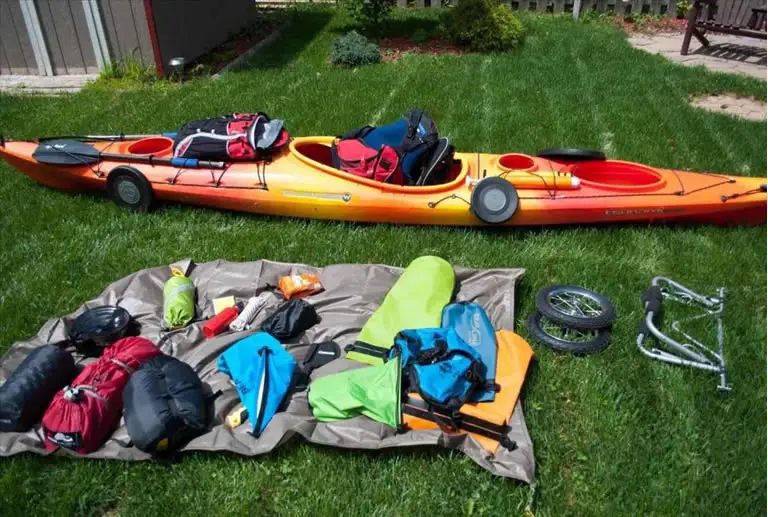
This will serve you well against ocean spray.
A helmet is another important safety item for ocean kayaking
Corded kayaking sunglasses will protect your eyes from the incessant glare reflected off the water.
I covered what to wear when kayaking at night here. That advice is equally as applicable to ocean kayaking where it can be colder than kayaking on more wind-protected inland waters.
If you intend to ocean kayak in the colder months be sure to also read our guide to kayaking in the winter.
That article shows you the additional precautions you need to take and additional equipment you will need.
9 Dangers of ocean kayaking
Ocean kayaking presents a challenge to even the most expert of kayakers. Mistakes made due to inexperience, or a change in weather conditions, while out at sea can cost lives.
Here are some of the major dangers you need to be aware of.
- Waves – Ocean or sea kayaks are designed to cope with waves, as explained below, but they are not immune to capsizing. Very large waves can precipitate a capsizing and only very experienced kayakers can handle extreme weather conditions on the ocean.
- Strong currents – The effect of strong currents on a kayak require physical effort and additional paddling to stay on course. An ocean kayaker needs to know the most effective ways of coping with strong currents which can move them significantly off course. The ocean kayaker also needs to have strong core strength and endurance.
- Rip currents – Rip currents are also a big danger when ocean kayaking. If you become caught in a rip current, you need the strength to paddle parallel to the current until you are clear of it. Paddling against a current directly will exhaust you and you won’t even make much progress. Be sure you follow our advice in the article How to Paddle Against The Current which will help you develop the necessary technique.
- Wash and wake – The recirculating water and waves generated by motorboats and large ships under power, which are commonplace in open waters, can create large waves and strong currents that can overwhelm a small boat easily.
- Storms – Conditions out at sea can change rapidly and storms will not only cause the sea conditions to deteriorate but also bring the risk of lightning strikes.
- Shock – Large open bodies of water, especially the ocean, tend to be cold. Capsizing in freezing waters can cause instant shock to the body which leads to disorientation, confusion and can lead to drowning.
- Hypothermia – Without proper precautions, prolonged journeys in very cold conditions can lead to a fall in body temperature. Falling into the freezing water can have the same effect. Both these scenarios can lead to hypothermia and even death if untreated.
- Sun exposure – In extreme heat, and/or direct sunlight, a kayaker is open to the effects of over-exposure to the sun and heat stroke.
- Sharks – Sharks can, and do, attack kayaks in the open sea by chasing and bumping them. Don’t think that staying close to the shoreline is a good defense as species like bull sharks may be found inshore. Sharks have been known to puncture hulls.
There are precautions you can take to address each of the potential problems listed above and we will explore these as we progress in this article.
How To Kayak In The Ocean 101
There will courses close to you that you can take which will help you develop the skills you need to safely tackle the ocean.
There are also courses available in different locations from Alaska to the Caribbean.
Ocean kayaking courses are excellent and if you get the chance to attend one we highly recommend you do so.
However, the best way to hone your skills and learn how to kayak effectively in the ocean is to go out on the water and do it.
But as a beginner you should always do it as part of a group, with experienced paddlers at its core!
Experience and practice are the best teachers but as a beginner never venture onto the ocean alone or with another beginner.
Ideally, ocean kayaking should never be undertaken alone – at least not until you are a very experienced open water paddler.
Kayaking in a group of competent paddlers will increase your chances of survival if you are capsized or run into serious problems in challenging conditions.
Paddling in groups means that your paddle-buddies can come to your aid in times of trouble and even help you re-enter your vessel if you capsize and have to exit your boat.
Ocean kayaking as part of a group with experienced ocean kayakers will also help you to build your skills and improve your technique much more quickly.
While kayaking with others you can mimic the more experienced paddlers around you and they will also undoubtedly give you tips while out on the water.
Kayaking in a group also allows you to gain much needed experience on open waters that you do not have the skill set to tackle alone.
You will even be able to tackle more challenging conditions.
If you are new to kayaking on the sea, do not be tempted to venture too far out, but rather remain a swimmable distance from shore.
Location and conditions should guide your decision when to and when not to enter the water.
How to start kayaking in the ocean
As mentioned previously the best way to start ocean kayaking is in one of two ways:
- Take a ocean kayaking course.
- Go out in a group with experienced ocean kayakers or sea kayakers that paddle in large open lakes.
My preference is do both.
Take a course from a reputable school or kayaker teacher and then find a group that will allow you to join or even just tag along for a few trips.
In truth I think that option 2 above is not really an option – it’s a necessity.
Venturing onto ocean waters alone without the skill set to tackle the challenges that can easily and quickly develop is too much of a risk.
Seek out kayaking clubs near you and join them.
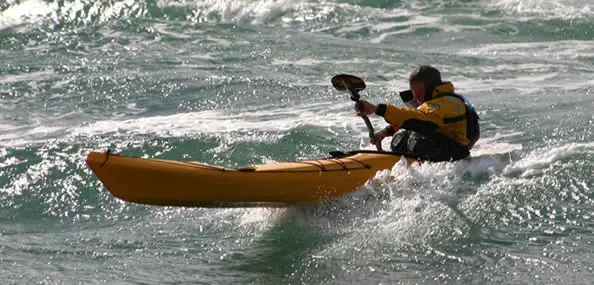
Inform the club of your goals and aims and let them help you build up your skills and learn the necessary techniques for taking on open waters.
- Do not be impatient.
- If your kayaking mentors want you to take it slow there is a good reason for their caution!
- You’ll get there in time, so just be patient.
The best time to kayak in the ocean
You have a broad understanding of what ocean kayaking involves.
So now you will want to know when you should partake in this water-based activity i.e., what is the best time to kayak in the ocean?
The best time to kayak in the ocean is in fine weather and calm water conditions.
The challenge of paddling against currents and through waves is less pronounced than it would be in the windier conditions.
The water will also be warmer as well as calmer.
The summer is an especially good time for beginners to take to the ocean.
As a beginner you are also more likely to capsize or go overboard, so avoiding cold winter waters is also advisable.
As your skill set improves and you become more experienced you may want to test yourself in more challenging conditions.
Winter ocean kayaking is perfectly fine as long as you have the skills to do it safely.
As I pointed out in this article winter kayaking also offers the paddler many benefits he/she does not get in the warmer months.
Rounding up: Ocean Kayaking For Beginners. How To Kayak In The Ocean
Sea or ocean kayaking offers the opportunity to access previously inaccessible areas of coastline and open waters.
It offers you the opportunity to have some truly amazing experiences that you would miss by just sticking to inland kayaking.
Touring on open waters, even in the winter, is a fantastic experience and by taking to the ocean, or other large body of water, your options are widened for exploration.
However, you must be aware that there are dangers associated with kayaking in the ocean that you may not have encountered, and may never encounter, while kayaking inland.
These dangers are not to be underestimated.
Even an experienced recreational kayaker could find themselves in serious trouble if they don’t have the proper technique and skillset needed to deal with challenging ocean conditions.
Kayakers that are new to sea kayaking need to be confident in their own skills before venturing into very large open waters alone.
A kayaker also needs a certain level of fitness to tackle ocean tides, currents and wave.
This form of kayaking requires a lot of physical effort and thus requires physical strength. This is especially true for core physical strength.
The best way to learn how to kayak in the sea is to take a course and gain some experience as part of an experienced group.
Once you are ready to hit the open water you must ensure that you are properly equipped which includes making sure you have the correct type of kayak and gear.

